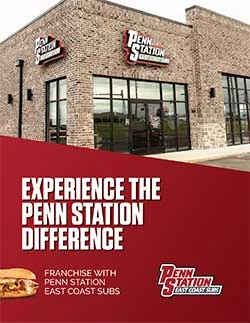4 Key Indicators of a Good Investment
Investing is one of the best ways to build wealth for yourself and generations to come, but, like all investments, it can be a risk. It’s important to look at investments closely before putting your hard-earned money into them. From stocks to art to franchises, there are a variety of passive and active ways to make your money work for you. Franchises have a unique return, not only giving back the initial investment and generating a return on investment (ROI), but also giving the franchisee an investment they truly own and can run. A restaurant franchise can be a profitable business venture when done correctly. The National Restaurant Association estimates in their 2022 State of the Restaurant Industry report that the foodservice industry will make $898 billion in sales in 2022 and grow to a workforce of nearly 15 million. To make sure you’re set up for success with your new venture, we’ve put together a list of key indicators to consider when looking into restaurants for sale.
Franchise vs Independently Owned Restaurants for Sale
The sandwich industry is much more than a foot long. This wide-ranging, growing industry is estimated by IBISWorld to employ about 375,000 people Restaurant ownership can come in a few different forms. The most common are privately owned independent restaurants or franchised restaurants. Let’s compare the two.
In a franchised restaurant, owners are essentially given a blueprint for how to run their business. The initial investment can be lower than building an independent restaurant from the ground up, but the biggest benefit of investing in franchise restaurants is the support behind the brand name. In addition to name recognition, franchises come with a standardized playbook for marketing, menu items, training, a technical stack of tools, and a knowledge base and support system to assist with every aspect of the business. Purchasing an existing franchise restaurant is often a great opportunity for both new investors and experienced ones with large portfolios.
Independently owned restaurants can have a local flair, but that can come at a price. Consumers may not be as familiar with a singular restaurant. This will come as a heavy haul for the owner to advertise the type of food served, the atmosphere, and location of the restaurant. Brand awareness leads to consumers trusting, knowing, and seeking out a business. Without it, a business will have to fight to make a name for themselves in an extremely competitive market. Additionally, independently owned restaurants may not have the bulk purchasing power with equipment and food vendors that franchise brands enjoy.
Indicators of a Good Investment
No business, including franchises, guarantee success. When making a large investment, it’s important to do your homework (including communicating with a brand’s franchisees) and weighing the pros and cons to make a decision that is right for your personal financial situation. We’ve broken down four of the most important indicators to look at when deciding on an investment.
1. Profit Margin
First and foremost, the goal for anyone who owns a business is to do something you are passionate about and to make money and turn a profit. When looking at potential restaurants to buy, examples of this may be located in the franchisor’s Franchise Disclosure Document Item 19 (“FDD”). Item 19 permits a franchisor to provide information about the actual or potential financial performance of the brand’s franchised and/or franchisor owned units. It’s not mandatory, and not all brands provide an earnings claim. During the due diligence phase, you should understand the franchisor’s performance representations intimately. If nothing is disclosed, ask yourself why that is.
Net profit margins may be calculated by taking the revenue earned and dividing it by the costs incurred. For example, at a restaurant, say it takes $10 of food and labor costs to assemble a sandwich you sell for $20. Let’s say there’s $1 for other fees and taxes. Subtract costs and fees ($3) from your revenue ($20), and you’ll find your profit of $6. Divide your profit by your revenue to determine the net margin. In this theoretical case, you’d have a 30% profit margin, and you’d be doing extremely well.
In reality, most restaurant profit margins may range from 0-15% with most averaging around a 3-5% profit margin, according to data from Upserve.
You can also look at the company’s free cash flow (“FCF”) as a whole. This is the amount of cash they have after paying for operational and capital expenses.
2. Return on Investment (“ROI”) and EBITDA
Slightly different from profit is the franchise ROI. For many restaurant franchisees, a good ROI to anticipate can be around a 10%-15% ROI per year, according to recent industry trends and historical data from CSIMarket.com, plus a salary for the work the owner does in the business. This could be higher if the franchise owner is also compensated as the general manager. Of course, prospective franchisees should always conduct their own significant due diligence since restaurant ROI will vary on location, demand, market, and sales.
Partnering with a franchise like Penn Station East Coast Subs can help your ROI potential with craveable product offerings, brand awareness, professional training, a simple, efficient operating platform, and ability to offer third party delivery and catering services.
In the latest FDD, Penn Station East Coast Subs franchisees saw an annual Earnings Before Interest, Taxes, Depreciation, and Amortization (“EBITDA”) ranging from about $68,000 to more than $650,000. In 2021, the average Penn Station EBITDA was approximately $160,000, with more than 40% of locations surpassing it.
3. The Market
A good investment, whether restaurants or another industry, should be in a growing and healthy market that the business owner is knowledgeable and excited for that sector. In the powerhouse restaurant industry, the sandwich segment is flourishing. According to the Franchise Times, over the last year, the Top 500 restaurant franchises (Penn Station is one of them) had a combined overall growth rate of more than 20%. Better yet, the sandwich industry is estimated to be worth $20 billion by IBISWorld. A Technavio report shows the sandwich industry will have a Compound Annual Growth Rate (CAGR) of more than 3.2%. These indicators point to a healthy thriving market and sub-market that make an investment worth the time and money for the investor. When looking at restaurants for sale, consider the specific market segment it’s in, and whether there are growth opportunities within that market.
4. Projected and Proven Growth
Aside from market growth, gaining an understanding of the company’s short- and long-term growth plan is integral when considering an investment. It is crucial to gain an understanding of how many new development territories the company may have and where investment opportunities may be headed. Look into the how the franchisees performed during and what they have experienced since COVID, especially for a restaurant. This might be a good indicator of how they support their restaurants and franchisees. Where is the franchise looking to expand, or are they at all? Do they assist franchisees by offering a Development Incentive Program in certain key areas where they are looking to expand? In the latest Franchise Times Top 500, Penn Station reports a sales growth of more than 21%, with significant growth plans for the future.
Why You Should Evaluate if a Penn Station East Coast Subs Franchise is the Right Brand for You
Penn Station East Coast Subs is an established brand and has strategically grown the last 37 years; that growth will not slow any time soon. With more than 300+ locations the brand believes it is just getting started. With an initial franchise fee of $25,000, a volume-based royalty of 2%-8% and a small national advertising fee, franchisees can serve their customers delicious, craveable sandwiches and other quality products that span both lunch and dinner dayparts.
Attractive development territories are still available in many major metropolitan areas Penn Station is committed to operational excellence and fantastic customer service. Penn Station won’t let franchisees open without training and support. the brand provides four weeks of training in Cincinnati, OH. Request information on franchising with Penn Station to begin your path to franchise ownership which can play a part in your journey to build individual and generational wealth.





